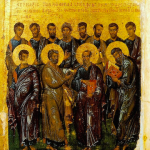Every image is a selection, and every selection hides. In the case of the pro-life movement, images of beautiful, happy babies exclude images of ugly, crying babies. Images of beautiful, wholesome pregnant women exclude images of ugly, miserable pregnant women. Images of happy, smiling Downs children exclude images of suffering Downs children.
It is a cheap shot to argue that these images lie. They don’t lie. There really are happy, beautiful babies. There really are wholesome, crunchy pregnancies. But these images can feed the very wolf that makes abortion possible, namely, the idea that babies are to be welcomed into existence only insofar as they are easy to welcome, beautiful to behold, comfortable to bear.
It is important to counteract the dreary pessimism that would describe all children as parasites, all pregnancy as an impending death, and all motherhood as an impossible task and a distraction from the goals of self-fulfillment. But we cannot counteract an inhuman view of the child with a superhuman one, replacing dire warnings with exclusively joyful promises. The image that appears to the mother of five as a “happy baby” or a “peaceful new mother” may appear to the person considering abortion as an impossible ideal. Surely the woman considering an abortion feels, more often than not, completely isolated from the proposed joys of pregnancy that positive baby-signs proclaim? To her, the net meaning of these signs is that the pro-life movement is protecting a certain kind of life, one that is foreign to the person undergoing a crisis pregnancy. Supportive families, smiling babies, loving fathers, perfect baby bumps, and Mother Theresa aren’t characters in every woman’s story. We wonder why people can see an image of the human child without being moved to act sacrificially, but it’s quite simple: that is not their child. That is not their pregnancy.
It is the unique difficulty and power of the pro-life movement that their fundamental argument is not expressed in utilitarian, but moral terms. The pro-life movement can say: “It will be difficult. You may even hate it. The child may drag you down; ruin your career; live in poverty; have a disease; suffer and die. Still, the human person is of a higher value than the values of career, comfort, and even health, and it would be wrong to sacrifice him or her for the sake of these joys.”
By simply presenting the “positive rewards” for not having an abortion we form one side of a counterfeit coin. The pro-choice movement argues that we need abortion because of the difficulties of pregnancy, while the pro-life movement, via the image, argues that we ought not have an abortion because of the joys of pregnancy. But it is a shallow ‘respect’ for those considering abortion that the means with which we motivate them is a rewards-based utilitarianism. A person should not procure an abortion for herself or another, not primarily because pregnancy is beautiful, children smile, and giving new life is full of consolations and comforts, but because it is wrong to murder another human being.
Genuine respect for the freedom of women does not consider them as beings motivated by ease and comfort, but as free, rational agents capable of sacrificing themselves in an encounter with the truth. By making the moral argument, the pro-life movement dares to humanize the woman as a moral agent. The pro-choice movement, by advocating abortion as a vaguely amoral position, judged, not by reason, but by uncriticizable personal choice, actually makes “choice” a shallow affair — do what you want, you cannot be wrong or right in your decision, for there is no definite meaning to your act.
The pro-choice movement absolves pregnant women from the responsibilities of freedom and the dictates of reason. They appear “pro-woman” by allowing women to appear subhuman, slaves to circumstance and preference, cut off from the moral universe in which every act has profound meaning. The transcendent command to “do good and avoid evil” is irrelevant to the woman soldiering through pregnancy — she is told that no dictate calls her to act, no moral judgment awaits her, and no “truth” inspires her. What is it to be pro-choice except to value “choice” itself over any question of whether one ought to make a good choice? One cannot help but see in this method the patriarchalism of the view by which women are incapable of rationality, unable to discern any transcendent truth or moral law, bound irrevocably to an immanent experience, circumstance, and environment. In the midst of this low estimation of the female capacity for truth and moral action, the pro-life movement dares to trouble the pregnant woman — treating her precisely as a free, rational, and moral person. The pro-life movement dares to tell suffering women to “do good and avoid evil” because we will not let the indignity of her suffering tempt us to the greater indignity of dehumanization. But this refusal to deny the difficulty of humanity to the pregnant woman is threatened by the reliance on the happy image which treats her as an amoral creature swayed by the promise of a happy reward.
Granted, I do not think that the answer to this problem is to counterbalance these positive images with negative ones, planting next to every baby-faced “protect life” sign an “…even when” sign — with a crying baby, a diseased baby, or an anxiety-riven mother. However, imagining our natural repulsion to such a manner of protest does drag our methods into the light of criticism. Why wouldn’t we mix our beautiful-baby signs with ugly-baby signs? Why wouldn’t we have every third pregnant-belly sign sliced through with a C-section scar? We, after all, claim to present “the truth about the child” via the use of the image. Why not present the whole truth?
Our answer would be that it would look negative, that it would feed into the lie that pregnancy is bad, that the child is no more than a burden, and so forth. But such a response calls our commitment into question — are we engaged in a discourse with free, rational human beings with the intention of motivating them to choose good and avoid evil by telling them the truth? Or are we engaged in a ideological non-discourse of swaying public opinion by presenting a selectively positive image to counteract a negative one?
The answer is not a greater diversity of pictures, but the courage to question the adage that “a picture is worth a thousand words.” In the case of the pro-life movement, I’d argue that a well-spoken word is worth a thousand pictures, and that the next great step for the movement lies precisely in becoming word-centered, or logos-centered, rather than image-centered.
















